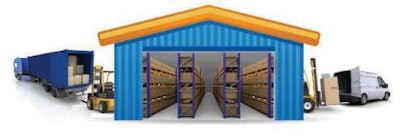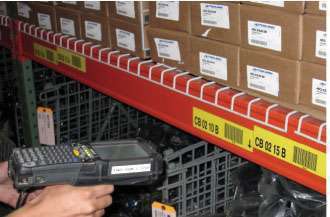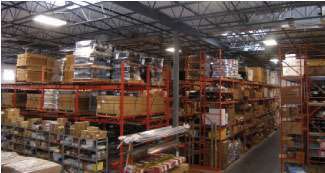
Improving warehouse efficiencies requires optimum layout and the right technologies.
Edward Neeley doesn’t like to let opportunities slip by and he doesn’t like to waste time. “I quit school because they had recess,” the president of Truck Supply of South Carolina jokes.
So when the land across the street from the company’s Columbia, S.C., headquarters went up for sale about three months ago, he looked out his window and he saw the future of his business.
Just six weeks after purchasing the property, Neeley says they already have blueprints drawn up for a new warehouse and retail store, and engineers already were walking the new land to make sure it would accommodate the building plans and conform to zoning laws and other regulations.
“Where we’re at right now, we’ve just outgrown it,” says Neeley. “The piece of property that we’re on now is more conducive to some other options. So when this other piece of property became available, we knew we had to look at it to try to get everything under one roof. We’re in three different buildings right now, but we’ll be able to put it all under one roof [when the facility is complete].”
It’s a realization that many distributors come to. Eventually, there comes a point when the business, if it is to continue to grow, needs to physically expand. The company simply needs more space if it plans to add volume or more product lines.
When that time comes, if the company does not want multiple branches by opening or acquiring a new business location, the options left on the table are to expand and renovate an existing location or go to a new location, one that already exists or one that needs to be built.

“Say, for instance, they need to expand, they need better cube utilization, they need more pallet positions, etc.,” says Ken Brzozowski, vice president of national accounts with the Raymond Corporation, manufacturers of lift trucks. “If they have the land adjacent to their business [large enough to accommodate their growth needs]…we would look at that, and we would try very hard to keep them on the existing land if possible. We would look at going with a more high density type approach – going higher with very narrow aisles if it’s applicable, and coming up with a number of alternatives to see if we can house the additional growth in the space available. If we could expand on the same property, obviously that’s a home run if you can do that.”
 Up, up and away is the way to go when it comes to racking. Warehouse designs should allow for the highest possible clear height allowable by law to maximize inventory capacity.
Up, up and away is the way to go when it comes to racking. Warehouse designs should allow for the highest possible clear height allowable by law to maximize inventory capacity.Brzozowski, who has been in this business for more than 30 years, says this is the technical investigation aspect of what Raymond does and can involve evaluating a number of possible layouts.
But when existing facilities fall short, finding a new home is the only way to go. That was the decision facing Neeley, and fortunately for him the new home just happened to be across the street.
Neeley says he believes in learning from others and not repeating mistakes peers have made. As a member of the TruckPride marketing group, he networked to identify other distributors with operations of similar size and scope. He then paid visits to their facilities, studying their warehouses, the flow of their work and other logistical aspects. His investigations took him to distributorships in Arizona, Florida, Georgia, New Jersey and New York.
“I believe everybody should get out and visit each other to see what they have and pick up different ideas. That’s the advice I have,” Neeley says. “Don’t sit home and try beating your head against the wall and try and recreate the wheel.”
KEEP IT CLOSE
One of the facilities Neeley visited was the headquarters for Automann in Somerset, N.J. There, he learned that some optimization strategies make so much sense that they sound simple. However, for companies steeped in routine, it may not be so obvious.
Many warehouse distributors organize inventory by product segments – all filters are in one location, all driveline components in another, etc. From an organizational standpoint, it makes perfect sense, but it may not be the best system for top productivity.
Automann, a master distributor of suspension and brake components, kept its inventory organized by product categories until the company moved into a new facility two years ago, which it built from scratch. With the move, it found a much more efficient way of doing it.
“The way we organize the warehouse is the items that are picked with greater frequency are kept in the front of the warehouse [nearest the shipping and receiving area],” says C.J. Khanduja, Automann’s vice president. “The items that are picked less frequently are in the rear of the warehouse. So the order pickers are not wasting time going back and forth for items that are popular.”
While logical, unless you’ve been exposed to this type of system or have had someone consult with you about its benefits, it may not be so apparent.
“Some companies might struggle to do that because they’re used to having things by product category, so that’s a change in the way you need to think about things. But once you do it, it’s not that difficult,” says Khanduja.
STACK IT
Regardless if you’re building a new facility or expanding an existing one, experts say to build the roof at the maximum height allowed by law. It’s a consideration Neeley says he’s incorporated into his new building design to allow for future growth.
The higher the ceilings, the higher the racks. The higher the racks, the more allowable lift clearance. The higher the lift clearance, the more inventory you can store.
Brzozowski says part of the technical investigation is to determine just how high the racks can go for maximum clear height, and an important part of that is to know what the local zoning laws and other regulations will allow. “Because you’ve got snow load situations you’re going to be dealing with, weather conditions, seismic activity, and all the other things that are going to come into place,” he says.
Allowable height has grown through the years, bolstered by higher quality construction and engineering. Brzozowski says when he first got into the business clear heights were at most about 20 feet. But that’s changed dramatically.
 Thinking Inside the Box---At its most basic level, the warehouse is a big box used to store smaller boxes. Products come in, are inventoried and then go out. The efficiency and accuracy of that flow of goods takes this basic principle to a scientific level. Warehouse layouts, racking configurations, inventory placement and logistics and material handling technologies all play a crucial role in determining productivity and profitability.
Thinking Inside the Box---At its most basic level, the warehouse is a big box used to store smaller boxes. Products come in, are inventoried and then go out. The efficiency and accuracy of that flow of goods takes this basic principle to a scientific level. Warehouse layouts, racking configurations, inventory placement and logistics and material handling technologies all play a crucial role in determining productivity and profitability.“As the years progressed, the size of the building became important because construction costs started to increase. So density was obviously an objective, but also, the cost of the expansion also became very involved in the conversation,” says Brzozowski. “I would say every 10 years the clear height would go up another 10 feet. It’s almost like a little rule of thumb. So the 20 footer became a 30-foot clear height. The 30-foot clear height became a 40-foot clear height. And now the 40-foot clear height becomes a 50-foot clear height. So people started to understand that the better the clear height, the more density you get and you can decrease the footprint. That’s the key thing, reducing the footprint.”
The spacing between racks also must be carefully considered. Narrow-aisle configurations allow for more racks, thus more inventory space, but it can’t be too narrow to create a dangerous or counterproductive picking environment. Usually a warehouse will combine a strategy of narrow and wide aisles. Lighter and less cumbersome products, such as a case of filters, can be stored in a narrow aisle, while more bulky and harder to maneuver components, such as transmissions, require wide aisles and should be stored as close to the ground as possible.
It also makes sense, Brzozowski says, to keep faster moving items on the floor because they can be moved in and out more quickly than those higher up on the racks.
The overall strategy, he says, is to create an “active band” that contains the most frequently picked products that can be accessed with the least amount of effort in the shortest possible time. “You create an active band relative to the movement by SKU,” Brzozowski says. “You keep the truck not having to lift all the way up because you’ll just lose time lifting. But in some cases, because it’s random, you’ll have to do that, it depends on how sophisticated the customer is in their inventory management and movement.
“Slotting is extremely importantly. It’s where you slot your product relative to accessing it and trying to active band it as best possible. The customers who do a good job at inventory management and location and slotting have better productivity rates.”
TRACK IT
Once the inventory is in the best possible place and you are making the most efficient use of space, technology is needed to track it with the greatest possible accuracy. That requires implementing a logistics management system that integrates key areas of your business and helps eliminate human error.
John Sterling, president and CEO of Foxfire, maker of warehouse logistics and management software, says any inventory tracking solution should communicate with the distributors’ business systems and account for all inventory from the moment it arrives until it’s sent out the door.
“We pick up the shipments when they come to the warehouse – and we know they’re coming because the software is talking to whatever accounting or ERP [enterprise resource planning] system the customer uses – so we know what to expect,” explains Sterling. “We receive it into the warehouse…and we’ve set the system up and configured it to know where the shipments are supposed to go in the warehouse, where the optimum place is for it.
“We keep track of any inventory movements in the warehouse, and when it’s time to ship an item, we know exactly where it is and we work with the accounting system to know when the orders need to be picked, what order should be picked and then we get it shipped out the door.”
Key to this process is bar coding.
 Though not in widespread use in the heavy-duty aftermarket, bar code technology improves inventory management and order accuracy.
Though not in widespread use in the heavy-duty aftermarket, bar code technology improves inventory management and order accuracy.Bar coding is not a new technology, but its adoption into the heavy-duty aftermarket has been slow, at best. While other industries that involve warehousing operations are adopting radio frequency identification technologies to track inventories, the trucking aftermarket is just starting to adopt bar coding with more fervor.
Typically, products arrive with, or are assigned upon receipt, a unique label identifier with a scannable series of lines, much like UPC codes used on retail products. The label is scanned with a handheld scanner and the product and its quantity is entered into the inventory tracking software. If configured to do so, the system also will let the warehouse employees know the exact location where this stock is to be stored, even routing the employees through the warehouse in the most efficient path.
When the company takes in an order, the order is relayed to the warehouse and a picker can again use the scanning device to navigate the aisles by the most efficient route, scanning the parts as they are collected to make sure the right parts are being picked and also to update the company’s inventory in real time.
While the task of having to inventory a warehouse full of products can be daunting, it is a system that can be cycled in gradually. “You start printing labels as items arrive, and then eventually that will cycle all through the warehouse,” says Sterling. “So it happens naturally as you start labeling your items.”
This method also can reveal what products have been sitting on your shelves for a long time and aren’t likely to move any time soon. If after a year there are components that still haven’t been assigned a bar code, you can assume these slow-moving parts may need a little help getting out the door with a specialized sales effort.
Among the benefits of bar coding, Sterling says, are reduced inventory shrinkage, less stock-outs and better inventory turns, all of which can help improve customer satisfaction.
There are also the financial benefits.
“These days…everyone has been asked to find ways to reduce costs in the way they operate the business. There’s an investment in our software, but there’s also a great payback,” Sterling says. “You can reduce labor. You get more organized so there is less labor to find and pick and ship items.”
He estimates that going from a manual or spreadsheet-based system to a bar-code system with logistics software can reduce warehouse labor requirements by as much as 50 percent.
Neeley said he plans to implement bar coding in his new facility, particularly because of its ability to keep products in healthy rotation and his inventory fresh.
“That was one of the things that we liked when we were up there [at Automann],” recalls Neeley. “They use their system to rotate stock and that’s what we want to do as well. You don’t want a case of filters to keep getting pushed to the back for two years because you keep getting new stock in.
“Just like a grocery store, you want the old stock out the door first.”
PICK IT
Getting products to and from the racks can be an art unto itself, and there are many configurations of lift trucks for a wide variety of applications. Usually a distributor will have at least two kinds in operation, a forklift-style truck to unload and load trailers in shipping and receiving, and one platform-style truck to work the aisles.
Brzozowski says during the technical investigation they determine the best lift equipment needed based on the configuration of the warehouse and flow of materials. The number of SKUs and pallet positions and the type and layout of racking all factor in. He says they can get creative in their solutions.
 Keeping the most frequently picked products nearest to the shipping/receiving area means employees are making fewer trips through the aisles, maximizing productivity.
Keeping the most frequently picked products nearest to the shipping/receiving area means employees are making fewer trips through the aisles, maximizing productivity.For instance, a dual-purpose machine can do both piece picking and pallet moving. “If the movement of pallets only requires three or four hours of work in a day, then it can be used for order picking the rest of the shift,” says Brzozowski. “So instead of just using it for full pallet movement, and then parking it for the rest of the day, that swing reach can be the piece-picking order picker at that point because it’s dual purpose.”
Safety also plays an important role in warehouse logistics. To help prevent lift-truck accidents, some warehouses, such as Automann, use a wire-guide system. This technology keeps lift trucks centered in aisles by locking the steer wheels in place via a buried cable. It’s a system that Brzozowski says “works like an invisible railroad track” and it can be retrofitted into existing warehouses.
“When you get on the wire, the steer tire is locked in place, your steering is locked, you can’t steer once you’re on the wire,” says Brzozowski. “You can only control up, down, forward and reverse.”
It’s a safety technology that Neeley says he’s considering for his new warehouse.
With plans in place and best practices of others noted and incorporated, Neeley hopes to have his new facility open for business by the beginning of 2011. The additional space – expected to be double his existing footprint at 22,500 sq.-ft. – will provide the company with needed volume capacity. Out of its Columbia facility, Truck Supply of South Carolina is averaging 4,500 pick tickets a month. The new warehouse will allow for about 6,000 pick tickets a month.
So, will that be the final move for the distributorship?
“It ought to cover us for another 12 to 15 years, with ease.” n







